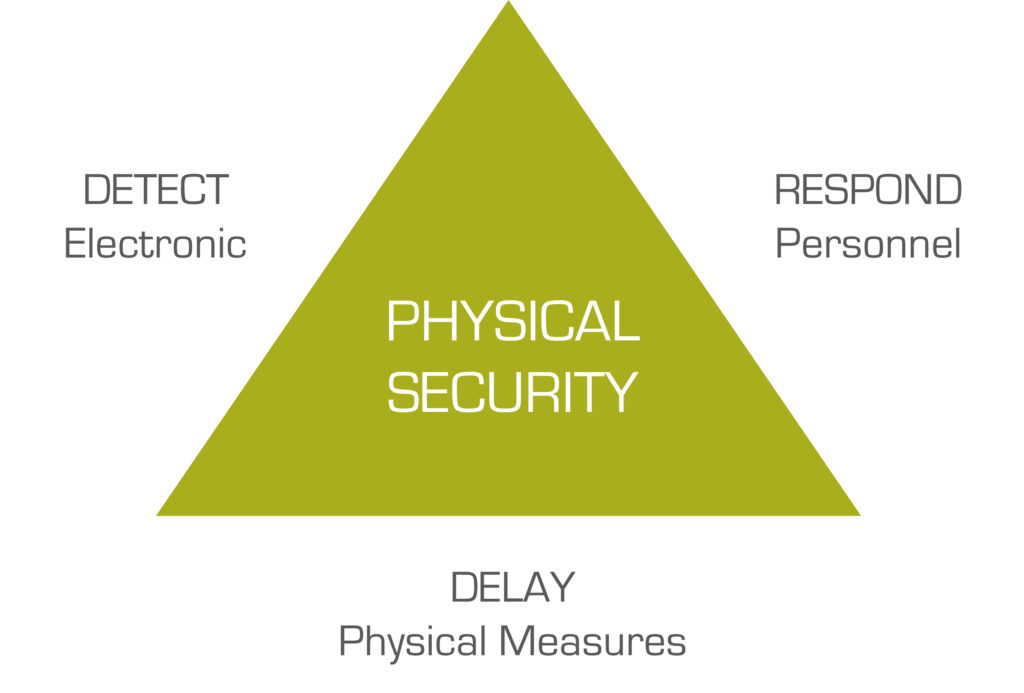What are common physical security threats?
When approaching a physical security plan, either for an existing property or new-build, it’s essential to have an understanding of common physical security threats and vulnerabilities, and how the different types of physical security threats should be approached. Inside this blog, we also explain how threats are linked to physical security risks and how to differentiate them.
Different types of physical security threats can be addressed within every stage of the design, implementation and maintenance of the property.
A landscape view of the threats, the accompanying vulnerabilities and available countermeasures are, therefore, in the property owner’s interest to understand.
So what are the common types of physical security threats? Here is an essential list of the risks this article covers:
-
Theft & Burglary
-
Vandalism
-
Sabotage
-
Terrorism
The Security Trifecta
Employed by much of the physical security (and cybersecurity) industry, there are three critical elements of an effective mitigation plan.
The Loss Prevention Certification Board (LPCB) describe this best:
“It is therefore always important to ensure suitable physical security measures are in place and that those measures provide sufficient delay to enable the intruder to be detected and a suitable response mounted to apprehend the intruder.”

Physical security, as shown in the image above, is vital within the deter and delay stage of an attack but not an end-all solution.
The concept of layered physical security sometimes referred to as defence in depth, allows for greater resilience.
Let’s get hypothetical;
A City Hall is undergoing a significant regeneration project.
The project is nationally funded public property, within a large city and offers three exhibition galleries.
There is to be heavy press coverage through-out the works as a controversial politician uses the property for regular meetings.

Small Crime, Low Priority
There are several elements to consider. As a prime property open to the public, vandalism and theft are likely.
Countermeasures for this severity of threat generally fall into the remit of deterrence or low profile mitigation.
Incidents such as these are generally unplanned, unorganised and pose little to no risk of damage or injury.
However, without measures meant to guard against them, they can be challenging to handle.
Vandalism of property and destruction of items can be a significant drain on resources.
Attackers are likely to use tools that can be carried on the person and make minimal noise.
Countermeasures such as a noticeable guard presence, network-based systems, i.e. CCTV or access control, and retrofit physical measures no higher than LPS 1175 Security Rating 3 (SR3).
Sabotage, Medium Priority
Art and cultural exhibitions feature items of high value, making them a target for sabotage and espionage. For a building to exhibit these valuables items, insurance is a necessity.
The Government Indemnity Scheme (GIS) supports cultural buildings to exhibit art by offering an alternative to insurance.
However, one of the many stipulations is high-performance physical security.
See our recent case study here for an in-depth explanation.
When considering our City Hall, the exhibition spaces have heavy footfall.
Countermeasures for the threat of sabotage should include measures of extensive personnel procedures to increase the chances of early detection.
Physical emergency lockdown products then assist should an incident occur.

Acts of Terror, High Priority
As a building relevant to the local government and occupied by political figures, more severe acts of sabotage or terror are also a concern.
Properties vital to national infrastructure are identified as CNI (Critical National Infrastructure).
A City Hall may not be high profile enough to warrant the involvement of the National Protective Security Authority (NPSA) formerly known as the CPNI (Centre for the Protection of National Infrastructure); however, the politician presents an additional physical security risk.
Attacks are incredibly challenging to predict, but there are patterns, such as multiple locations.
One horrific example of such a pattern is the New Zealand Mosque Attack on 15 March. The gunman made his way through two properties without restriction.
The countermeasures for acts of terror are therefore centred around delaying an incident. This allows occupants to move to a safe location. Internal safety enclosures with heavy-duty physical reinforcements offer better protection than no protection at all.
Utility of Physical Security Countermeasures
The threats identified affect one or more of the following: the safety of the occupants, the state of the resources, or the protection of the property.
Each of the threats identified in our hypothetical scenario acknowledges the vulnerability of a different section of the property.

From this basic diagram, it is clear to see how a layered approach to common physical security threats and vulnerabilities can be implemented.
- Exterior: Access control procedures and certified security measures mitigate most attempts.
- Interior: Reinforcement using intelligent countermeasures against more determined and professionals attempts.
- Asset: Internal enclosures fortified against extreme attack with emergency lockdown and rapid response.
How Are Physical Security Risks and Threats Connected? and How Do They Differ?
Physical security risks are at the base level of any security concern. Risks can exist without a threat but not vice versa.
Physical security risk is a circumstance of exposure to danger. For example minimum control of entry and exit activity, having computers or laptops left unattended on desks or lack of appropriate security training for staff.
On the other hand, physical security threats involve an intention or abuse of power to cause damage to property or steal something.
In the physical security world, you should never allow for risk. Underestimating this opens the door to potential threats.
A clear understanding of physical security risks and physical security threats about your property will pave the way for planning a security strategy.
Other Common Physical Security Threats
The other types of physical security threats and vulnerabilities that have not been identified here include those posed to the property perimeter.
The inclusion of countermeasure against Hostile Vehicle Mitigation (HVM) involves limiting the number of vehicles that access the site and provide protection against vehicle impact.
Check out our previous article on HVM for more information.
–
If you require advice about any of the issues mentioned, please do not hesitate to get in touch using the form below.
Alternatively, please call 0845 050 8705 to speak with a member of our team.







